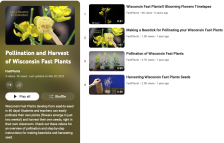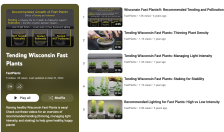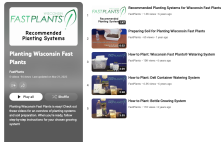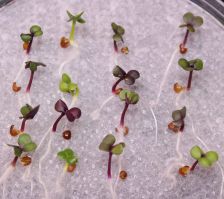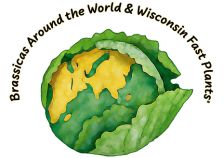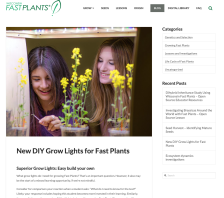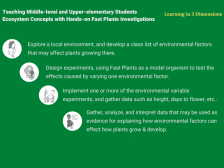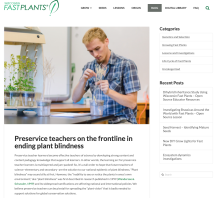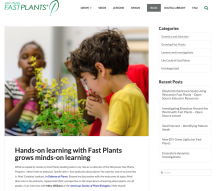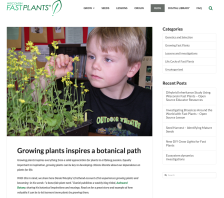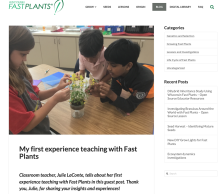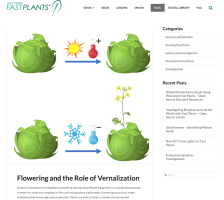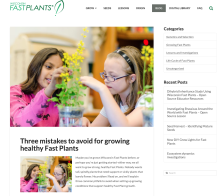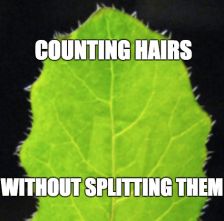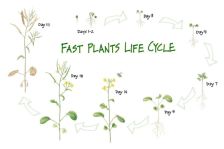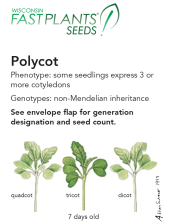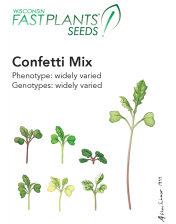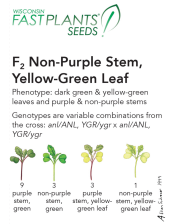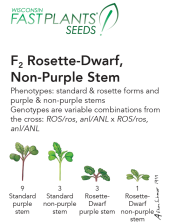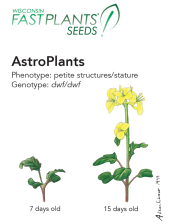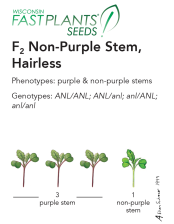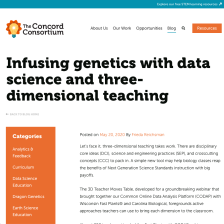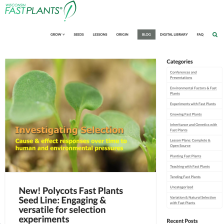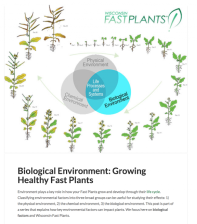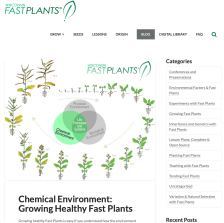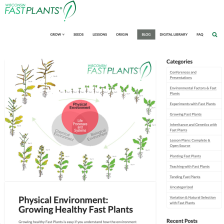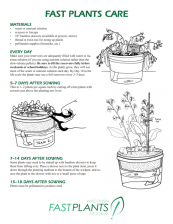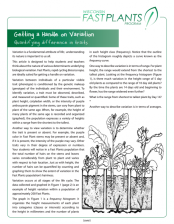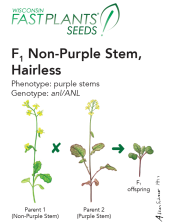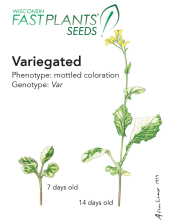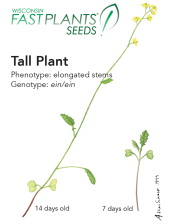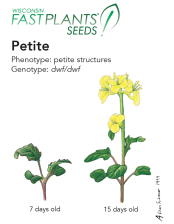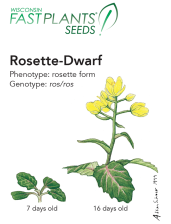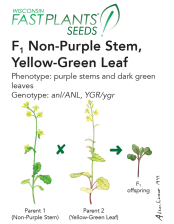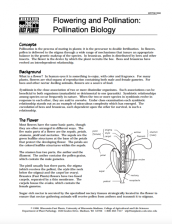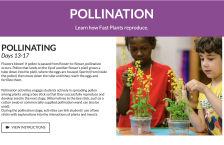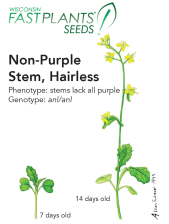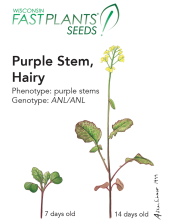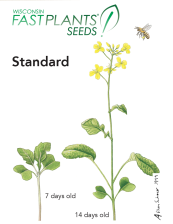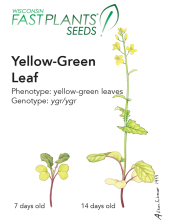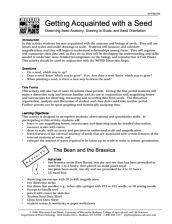Browse Resources
(4 classifications) (47 resources)
| Educational Standard
(1)
FAQ (3) Glossary/Index (3) |
Scientific research
(2)
|
Resources | |
|---|---|
Preparing Your Students for the Future: Undergraduate Research Experiences with RapidCycling BrassicThis article with practical instructions about using Fast Plants in undergraduate research experiences was published as an addendum to a workshop given at the 2017 ABLE Conference in Madison, WI. Contains ideas for helping students at high school and undergraduate levels to conduct independent...
This YouTube playlist curated by the Wisconsin Fast Plants Program provides an overview and then demonstrates how to pollinate and harvest seeds from Fast Plants.
This YouTube playlist curated by the Wisconsin Fast Plants Program provides an overview and then demonstrates recommended tending (thinning, managing light intensity, and staking) to help grow healthy, happy plants!
This YouTube playlist curated by the Wisconsin Fast Plants Program provides an overview and then demonstrates planting Fast Plants in three wicking growing systems that are recommended for growing Fast Plants. Two of the recommended systems are built from easily found recycled plastic containers:...
This blog post from the Wisconsin Fast Plants features open source educator resources, developed in 2023. These resources support the teaching of genetics concepts with tools focused on a Dihybrid Inheritance Study. This study provides a two-week approach for observing three generations of plant...
This blog post from the Wisconsin Fast Plants features open source educator resources, developed in 2023. These NGSS- and Ag-Standards aligned resources, named Investigating Brassicas Around the World with Fast Plants include a full lesson plan with supporting plant breeding activities, video about...
This blog post by the Fast Plants Team provides a materials list and instructions for a Do-It-Yourself, LED Grow Light that is ideal for Fast Plants growth. This grow light uses cost-effective materials that can be obtained online and from a local hardware store. The light is easy to construct,...
This blog post from the Wisconsin Fast Plants website features an NGSS-aligned Open Source Lesson Plan for Investigating Ecosystem Dynamics with Fast Plants. The featured lesson plan is available to be downloaded and edited as needed via Google Drive. The investigation challenges students to gather...
This blog post on the Fast Plants website discusses the concept of plant blindness (the inability to see or notice the plants in one's own environment) and the importance of ending plant blindness and supporting plant vision. Fast Plants are an effective introduction to growing and noticing plants:...
This blog post on the Fast Plants website shares content from podcaster, Matt Candeias, host of the In Defense of Plants podcast. In an interview with Mary Williams of the American Society of Plant Biologists, Matt discusses the important connection fostered between physical experiences and...
This blog post shared on the Wisconsin Fast Plants website is a guest post by Daniel Murphy, author of the weekly blog Awkward Botany. In this post, Daniel shares his firsthand account of his experiences growing plants and becoming "a bona fide plant nerd." This post is a great example of the value...
This blog post from the Wisconsin Fast Plants website is a guest post by classroom teacher, Julie LaConte, of Rossman School in Creve Coeur, MO. In this post, Julie describes her experiences researching, preparing for, and teaching with Fast Plants in her classroom. Thank you for sharing your...
This blog post on the Wisconsin Fast Plants website features the recently released Wisconsin Fast Plants genetics simulations, powered by ExploreLearning Gizmos. Sign up for a free account on the Gizmo website (https://www.explorelearning.com/index.cfm?method=Controller.dspFreeAccount) for free...
This blog post, written by the MiniPCR Team, describes the use of biotechnology kits and equipment (available from multiple suppliers) in the classroom to help students and learners understand the connection between observable phenotypic traits and underlying genotypes. These investigations can be...
This blog post from the Wisconsin Fast Plants website describes the value of using Fast Plants as a model organism for biological and environmental investigations. This post is primarily an index of Fast Plants resources, providing prompts for teaching goals and suggesting Fast Plants kits...
This blog post from the Fast Plants Team addresses the question "Do Fast Plants need Vernalization to Flower?". This post describes the concept of vernalization (requiring a cold period to induce flowering) and its role in regulating the development of flower structures in flowering plants. Some...
This blog post from the Wisconsin Fast Plants Team describes three ways to optimize your growing environment to grow healthy Fast Plants.
Tips for growing healthy plants are focused around the following three concepts, with descriptions of ideal environmental conditions for each:
1. Not enough...
This blog post from the Wisconsin Fast Plants website describes the observation of plant hairs (trichomes) for conducting a selective breeding experiment (such as in AP Biology investigations). The number of hairs is variable in Fast Plants seed varieties, and selection for or against plant...
This blog post from the Wisconsin Fast Plants website describes the value of using Fast Plants as a model organism to teach plant life cycles at multiple grade levels. Content includes an overview of plant growth stages (including videos) and links to resources and activities that can enrich...
This is a page on the Fast Plants website, describing the Polycot variety of Fast Plants (Brassica rapa). Two generations of the Polycot variety are available, each with a different % of expression of the polycot trait. This page includes suggestions for investigations and teaching applications...
This is a page on the Fast Plants website, describing the Confetti Seed Mix variety of Wisconsin Fast Plants (Brassica rapa). Confetti Mix includes phenotypes from several Fast Plants varieties, including purple stem, non-purple stem, yellow-green leaf, rosette-dwarf, tall plant, petite, variegated,...
This is a page on the Fast Plants website, describing the F2 Non-Purple Stem, Yellow-Green Leaf variety of Fast Plants (Brassica rapa). This page includes suggestions for investigations and teaching applications using this seed variety, including use as a model organism in teaching Mendelian...
This is a page on the Fast Plants website, describing the F2 Rosette-Dwarf, Non-Purple Stem variety of Fast Plants (Brassica rapa). This page includes suggestions for investigations and teaching applications using this seed variety, including use as a model organism in teaching Mendelian genetics...
This is a page on the Fast Plants website, describing the F1 Rosette-Dwarf, Non-Purple Stem variety of Fast Plants (Brassica rapa). This page includes suggestions for investigations and teaching applications using this seed variety, including use as a model organism in teaching Mendelian genetics...
This is a page on the Fast Plants website, describing the AstroPlants variety of Fast Plants (Brassica rapa). This page includes suggestions for investigations and teaching applications using this seed variety.
This is a page on the Fast Plants website, describing the F2 Non-Purple Stem variety of Fast Plants (Brassica rapa). This page includes suggestions for investigations and teaching applications using this seed variety, including use as a model organism in teaching Mendelian genetics with a monohybrid...
This blog post, written by Frieda Reichsman, discusses how educators can implement three-dimensional teaching methods into classrooms and meet the Next Generation Science Standards. The article introduces the 3D Teacher Moves Table, a lesson-planning tool created by Hedi Lauffer at Wisconsin Fast...
This blog post from the University of Wisconsin-Madison's Wisconsin Fast Plants, describes an investigation that educators can implement in the classroom to facilitate students' learning about variation and natural selection through firsthand observations and hands-on data collection in a very short...
Read this blog post for background information about the relationship between the biological environment and life processes and systems in Fast Plants.
Growing healthy Fast Plants is easy if you understand how the environment can affect growth and development. Three broad categories of...
Read this blog post for background information about the relationship between the chemical environment and life processes and systems in Fast Plants. Growing healthy Fast Plants is easy if you understand how the environment can affect growth and development. Three broad categories of environmental...
Read this blog post for background information about the relationship between the physical environment and life processes and systems in Fast Plants.
Growing healthy Fast Plants is easy if you understand how the environment can affect growth and development. Three broad categories of environmental...
This four-page handout explains the key steps to follow when caring for Wisconsin Fast Plants (Brassica rapa) throughout their life cycle, from sowing through harvesting seeds. This handout includes information about the materials needed, methods for tending and caring for your plants, and...
This article is designed to help students and teachers think about the nature of various determinants underlying biological variation. Teachers facilitating any selection investigation will find this background information helpful, including those planning for the AP Biology Lab 1 of Big Idea 1:...
This is a page on the Fast Plants website, describing the F1 Non-Purple Stem variety of Fast Plants (Brassica rapa). This page includes suggestions for investigations and teaching applications using this seed variety, including use as a model organism in teaching Mendelian genetics with a monohybrid...
This is a page on the Fast Plants website, describing the Non-Purple Stem, Yellow-Green Leaf variety of Fast Plants (Brassica rapa). This page includes suggestions for investigations and teaching applications using this seed variety.
This is a page on the Fast Plants website, describing the Variegated variety of Fast Plants (Brassica rapa). This page includes suggestions for investigations and teaching applications using this seed variety.
This is a page on the Fast Plants website, describing the Tall Plant variety of Fast Plants (Brassica rapa). This page includes suggestions for investigations and teaching applications using this seed variety.
This is a page on the Fast Plants website, describing the Petite variety of Fast Plants (Brassica rapa). This page includes suggestions for investigations and teaching applications using this seed variety.
This is a page on the Fast Plants website, describing the Rosette-Dwarf variety of Fast Plants (Brassica rapa). This page includes suggestions for investigations and teaching applications using this seed variety.
This is a page on the Fast Plants website, describing the F1 Non-Purple Stem, Yellow-Green Leaf variety of Fast Plants (Brassica rapa). This page includes suggestions for investigations and teaching applications using this seed variety, including use as a model organism in teaching Mendelian...
This pdf includes background information and an activity for engaging students in the processes that occur during pollination, fertilization and seed development in Fast Plants. Pollination is explained and illustrated and an activity for students to pollinate Fast Plants and observe reproductive...
This webpage from the Fast Plants website explains how to pollinate Fast Plants, including instructions for making bee sticks and pollination videos and tips.
This is a page on the Fast Plants website, describing the Non-Purple Stem Hairless variety of Fast Plants (Brassica rapa). This page includes suggestions for investigations and teaching applications using this seed variety.
This is a page on the Fast Plants website, describing the Purple Stem, Hairy variety of Fast Plants (Brassica rapa). This page includes suggestions for investigations and teaching applications for using this seed variety.
This is a page on the Fast Plants website, describing the Standard variety of Wisconsin Fast Plants (Brassica rapa). This page includes suggestions for investigations and teaching applications using this seed variety, including use as a model organism to teach about the plant life cycle and plant...
This is a page on the Fast Plants website, describing the Yellow-Green Leaf variety of Fast Plants (Brassica rapa). This page includes suggestions for investigations and teaching applications using this seed variety.
Description: In this activity students become acquainted with the anatomy and biology of seeds. They will use lenses and scales and make drawings to scale. Students will measure and calculate magnifications and they will begin to understand relationships among these. They will organize and summarize...
| |

